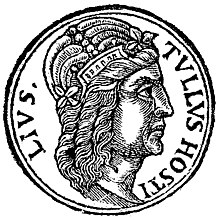Tullus Hostilius
| Tullus Hostilius | |
|---|---|
 Tullus Hostilius, 16th-century woodcut by Guillaume Rouillé | |
| King of Rome | |
| Reign | c. 672–640 BC |
| Predecessor | Numa Pompilius |
| Successor | Ancus Marcius |

Tullus Hostilius (
Tullus Hostilius was the grandson of
The principal feature of Tullus' reign was the
Historical events
Two distinctive events are traditionally ascribed to Tullus's reign. Historians regard the events as having taken place during the early regal period, but the question of whether the events should be directly associated with Tullus is debatable.
The first event is the destruction of Alba Longa. The historical record shows that the Alban Hills were the site of a large settlement and that this settlement fell under Roman power during the regal period. Details are uncertain about when and by whom Alba Longa was destroyed. It was almost certainly subjugated at a later date than that given by Livy and it may have been destroyed by the Latins and not by the Romans (who might have regarded the destruction of their own traditional mother-country as impious).[citation needed]
Wars with Alba Longa
The battle of Alba Longa was settled by having two sets of triplets, one born in Alba Longa and one in Rome, fight for their city. The last person standing alive would be the winner, and his city would win the war without having their armies engage in battle. The story states that these triplets were singled out as champions of both cities.[7] According to Livy, the triplets were named Horatii and Curiatii, and the majority believed that the Horatii belonged to Rome and the Curiatii to Alba Longa, though this is not certain.[8] After battling for a long time, one of the Roman brothers was victorious, thus Rome and Tullus Hostilius won the battle.[9]
The Alban dictator Mettius Fufetius betrayed Rome during the war with the Etruscans, where Rome requested Alban military assistance, which Mettius agreed to, but also had a secret agreement with the Etruscans to desert Rome in the heat of battle, leaving Tullus alone to fight the battle. Mettius also betrayed the Etruscans by not joining in the battle at all.[10] Tullus won the battle despite the betrayal. Mettius was taken prisoner by Tullus.[5]
Tullus ordered Alba Longa to be destroyed and forced the migration of the Alban citizenry to Rome, where they were integrated and became Roman citizens. For the betrayal of Rome, Tullus had Mettius Fufetius tied between two chariots; the horses then ripped Mettius into two pieces.[10] According to Livy, this was the first and last time the Romans used this method of execution.[10]
Construction of the Curia Hostilia
Tullus's second alleged historical accomplishment was the construction of the original Roman Senate house, the
Myth

As with those of all the early kings of Rome, the events ascribed to the reign of Tullus Hostilius are treated with scepticism by modern historians. Part of this is due to obvious flaws in the literary tradition describing the kings: much like the confusion the Ancients exhibited in attributing identical accomplishments to both
Hostilius was probably a historical figure, however, in the strict sense that a man bearing the name Tullus Hostilius likely reigned as king in Rome. The most compelling evidence is his name: "Tullus" is an unusual praenomen in Roman culture, and his gentile name is obscure and linguistically archaic enough to rule out the possibility that he was a crude later invention.
Death
According to
There are two stories concerning the death of Tullus Hostilius and his family. The first is that his house was hit by lightning and burned to the ground with no survivors. The second is that Ancus Marcius and some of his followers went to Tullus Hostilius's home with swords hidden under their robes. Once inside the home, the party killed Tullus, his family, and their servants and razed the property to ensure there would be no heir to the throne. [13][10]
In fiction
Incidents from legends surrounding Tullus Hostilius were used as the basis of opera librettos during the baroque period in music, beginning with a Tullo Ostilio opera performed in Rome in 1694 with music of Giovanni Bononcini. Operatic pastiches with the title Tullo Ostilio performed in Prague in 1727 and Brno in 1735 included music of Antonio Vivaldi. Consistent with contemporary conventions, the stories concentrate on concocted love stories involving members of the principal character's family.
Tullus Hostilius was played by
Tullus is briefly mentioned in the Aeneid in the description of Aeneas' shield. He is described as hauling away the remains of the liar Mettius through the brush.
He is a character in Philip José Farmer's novel To Your Scattered Bodies Go, the first of the Riverworld series. After the Resurrection, he has teamed up with Hermann Göring to run a slave state.
See also
References
- ^ "Titus Livius (Livy), The History of Rome, Book 1, chapter 22". www.perseus.tufts.edu. Retrieved 2020-12-12.
- ^ "Titus Livius (Livy), The History of Rome, Book 1, chapter 31". www.perseus.tufts.edu. Retrieved 2020-12-12.
- ^ Penella, Robert J. (1990/05). "Vires/Robur/Opes and Ferocia in Livy's Account of Romulus and Tullus Hostillus". The Classical Quarterly. 40 (1): 207–213.
- ^ Livy, History of Rome, I
- ^ Ab urbe condita, 1:22
- ^ Plutarch. The Life of Numa. p. 21.
- ^ "Titus Livius (Livy), The History of Rome, Book 1, chapter 24". www.perseus.tufts.edu. Retrieved 2020-12-08.
- ^ "Titus Livius (Livy), The History of Rome, Book 1, chapter 24". www.perseus.tufts.edu. Retrieved 2020-12-12.
- ^ "Titus Livius (Livy), The History of Rome, Book 1, chapter 25". www.perseus.tufts.edu. Retrieved 2020-12-12.
- ^ ISBN 978-1-4443-3838-6
- ^ "Titus Livius (Livy), The History of Rome, Book 1, chapter 30". www.perseus.tufts.edu. Retrieved 2020-12-12.
- ^ a b Cornell, T. J. (1995). The Beginnings of Rome: Italy and Rome from the Bronze Age to the Punic Wars (c. 1000–264 BC). London and New York: Routledge. p. 71.
- ^ Dionysius of Halicarnassus (lll.35.3-4.).

